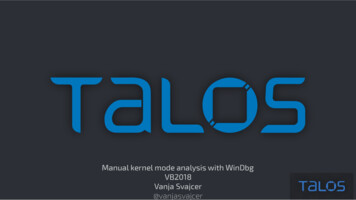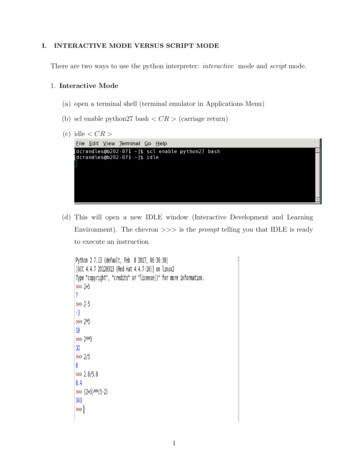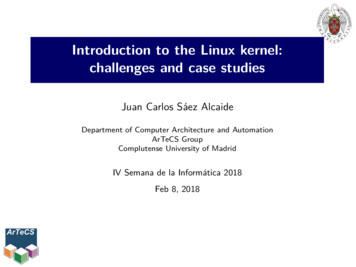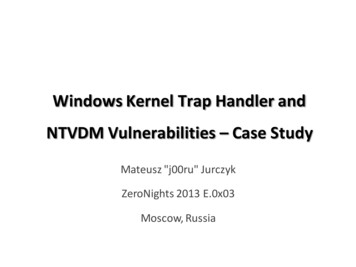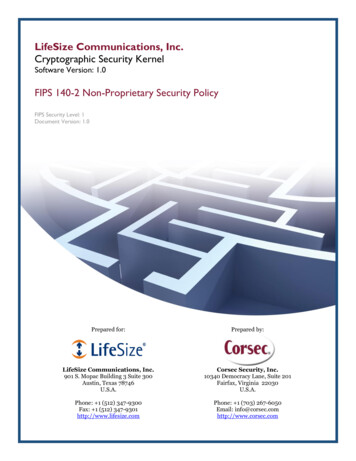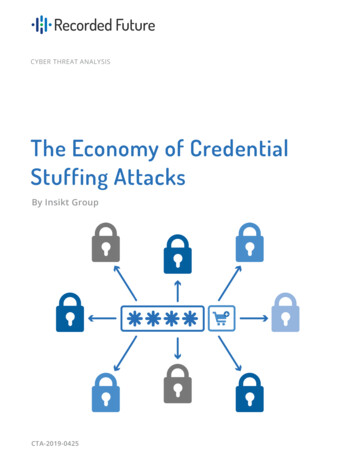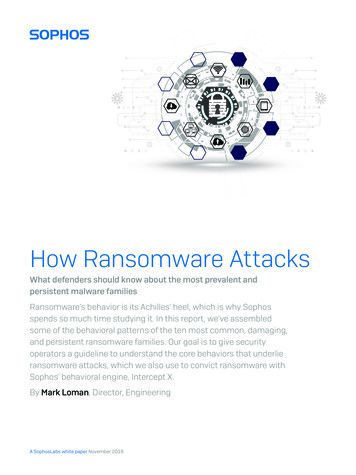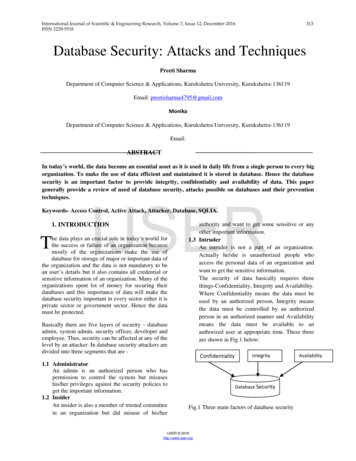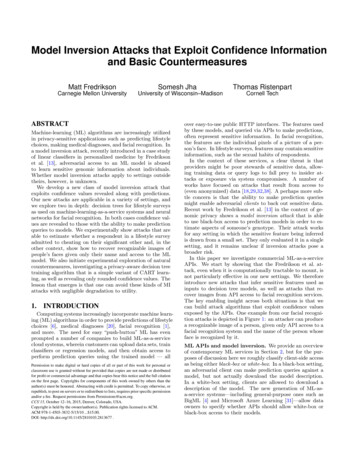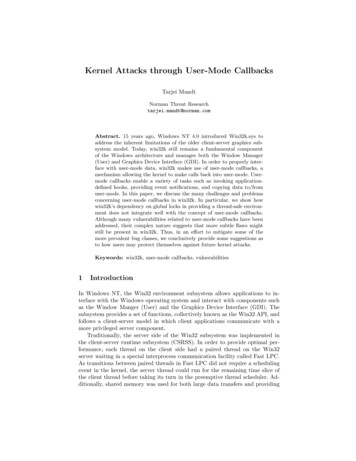
Transcription
Kernel Attacks through User-Mode CallbacksTarjei MandtNorman Threat Researchtarjei.mandt@norman.comAbstract. 15 years ago, Windows NT 4.0 introduced Win32k.sys toaddress the inherent limitations of the older client-server graphics subsystem model. Today, win32k still remains a fundamental componentof the Windows architecture and manages both the Window Manager(User) and Graphics Device Interface (GDI). In order to properly interface with user-mode data, win32k makes use of user-mode callbacks, amechanism allowing the kernel to make calls back into user-mode. Usermode callbacks enable a variety of tasks such as invoking applicationdefined hooks, providing event notifications, and copying data to/fromuser-mode. In this paper, we discuss the many challenges and problemsconcerning user-mode callbacks in win32k. In particular, we show howwin32k’s dependency on global locks in providing a thread-safe environment does not integrate well with the concept of user-mode callbacks.Although many vulnerabilities related to user-mode callbacks have beenaddressed, their complex nature suggests that more subtle flaws mightstill be present in win32k. Thus, in an effort to mitigate some of themore prevalent bug classes, we conclusively provide some suggestions asto how users may protect themselves against future kernel attacks.Keywords: win32k, user-mode callbacks, vulnerabilities1IntroductionIn Windows NT, the Win32 environment subsystem allows applications to interface with the Windows operating system and interact with components suchas the Window Manger (User) and the Graphics Device Interface (GDI). Thesubsystem provides a set of functions, collectively known as the Win32 API, andfollows a client-server model in which client applications communicate with amore privileged server component.Traditionally, the server side of the Win32 subsystem was implemented inthe client-server runtime subsystem (CSRSS). In order to provide optimal performance, each thread on the client side had a paired thread on the Win32server waiting in a special interprocess communication facility called Fast LPC.As transitions between paired threads in Fast LPC did not require a schedulingevent in the kernel, the server thread could run for the remaining time slice ofthe client thread before taking its turn in the preemptive thread scheduler. Additionally, shared memory was used for both large data transfers and providing
clients read-only access to server managed data structures to minimize the needfor transitions between clients and the Win32 server.In spite of the performance optimizations made to the traditional Win32 subsystem, Microsoft decided with the release of Windows NT 4.0 to migrate a largepart of the server component into kernel-mode. This lead to the introduction ofWin32k.sys, a kernel mode driver managing both the Window Manager (User)and the Graphics Device Interface (GDI). The move to kernel-mode greatly reduced the overhead associated with the old subsystem design, by having farless thread and context switches (and using the much faster user/kernel transition) and reducing memory requirements. However, as user/kernel transitionsare relatively slow compared to direct code/data access within the same privilege level, some old tricks such as caching of management structures in theuser-mode portion of the client’s address space were still maintained. Moreover,some management structures were stored exclusively in user-mode in order toavoid ring transitions. As Win32k needed a way to access this information andalso support basic functionality such as windows hooking, it required a way topass control to the user-mode client. This was realized through the user-modecallback mechanism.User-mode callbacks allow win32k to make calls back into user-mode andperform tasks such as invoking application-defined hooks, providing event notifications, and copying data to/from user-mode. In this paper, we discuss themany challenges and problems concerning user-mode callbacks in win32k. Inparticular, we show how win32k’s design in preserving data integrity (such as inrelying on global locking) does not integrate well with the concept of user-modecallbacks. Recently, MS11-034 [7] and MS11-054 [8] addressed several vulnerabilities in an effort to address multiple bug classes related to user-mode callbacks.However, due to the complex nature of some of these issues and the prevalenceof user-mode callbacks, more subtle flaws are likely to still be present in win32k.Thus, in an effort to mitigate some of the more prevalent bug classes, we conclusively discuss some ideas as to what both Microsoft and end-users might doto further mitigate the risk of future attacks in the win32k subsystem.The rest of the paper is organized as follows. In Section 2, we review background material necessary to understand the remained of the paper, focusedon user objects and user-mode callbacks. In Section 3, we discuss function namedecoration in win32k and present several vulnerability classes peculiar to win32kand user-mode callbacks. In Section 4, we evaluate the exploitability of vulnerabilities triggered by user-mode callbacks, while we in Section 5 attempt to address these attacks by proposing mitigations for prevalent vulnerability classes.Finally, in Section 6 we provide thoughts and suggestions on the future of win32kand in Section 7 we provide a conclusion of the paper.2BackgroundIn this section, we review the background information necessary to understandthe remainder of the paper. We begin by briefly introducing Win32k and its
architecture, before moving onto more specific components such as the WindowManager (focused on user objects) and the user-mode callback mechanism.2.1Win32kWin32k.sys was introduced as part of the changes made in Windows NT 4.0 toincrease graphics rendering performance and reduce the memory requirements ofWindows applications [10]. Notably, the Windows Manager (User) as well as theGraphics Device Interface (GDI) were moved out of the client-server runtime subsystem (CSRSS) and implemented into a kernel module of its own. In WindowsNT 3.51, graphics rendering and user interface management were performed byCSRSS using a fast form of interprocess communication between the application(client) and the subsystem server process (CSRSS.EXE). Although this designwas optimized for performance, the graphics intensive nature of Windows leaddevelopers to move to a kernel based design with the much faster system calls.Win32k essentially consists of three major components: the Graphics DeviceInterface (GDI), the Window Manager (User), and thunks to DirectX APIs tosupport both the XP/2000 and Longhorn (Vista) display driver models (sometimes also considered to be a part of GDI). The Window Manager is responsiblefor managing the Windows user interface, such as controlling window displays,managing screen output, collecting input from mouse and keyboard, and passing messages to applications. GDI, on the other hand, is mostly concerned withgraphics rendering and implements GDI objects (brushes, pens, surfaces, devicecontexts, etc.), the graphics rendering engine (Gre), printing support, ICM colormatching, a floating point math library, and font support.As the traditional subsystem design of CSRSS was built around having oneprocess per user, each user session has its own mapped copy of win32k.sys. Theconcept of sessions also allows Windows to provide a more strict separationbetween users (otherwise known as session isolation). As of Windows Vista, services were also moved into their own non-interactive session [2] to avoid thearray of problems associated with shared sessions such as shatter attacks [12]and vulnerabilities in privileged services. Moreover, User Interface Privilege Isolation (UIPI) [1] implements the concept of integrity levels and ensures that lowprivilege processes cannot interact (e.g. pass messages to) processes of a higherintegrity.In order to properly interface with the NT executive, win32k registers severalcallouts (PsEstablishWin32Callouts) to support GUI oriented objects such asdesktops and window stations. Importantly, win32k also registers callouts forthreads and processes to define per-thread and per-process structures used bythe GUI subsystem.GUI Threads and Processes As not all threads make use of the GUI subsystem, allocating GUI structures up front for all threads would be a waste ofspace. Hence, all threads on Windows start as non-GUI threads (12 KB stack).If a thread accesses any of the USER or GDI system calls (number 0x1000),
Windows promotes the thread to a GUI thread (nt!PsConvertToGuiThread)and calls the process and thread callouts. Notably, a GUI thread has a largerthread stack to better deal with the recursive nature of win32k as well as supportuser-mode callbacks which may require additional stack space1 for trap framesand other metadata.When the first thread of a process is converted to a GUI thread and callsW32pProcessCallout, win32k calls win32k!xxxInitProcessInfo to initializethe per-process W32PROCESS/PROCESSINFO2 structure. Specifically, this structureholds GUI-related information specific to each process such as the associateddesktop, window station, and user and GDI handle counts. The function allocatesthe structure itself in win32k!AllocateW32Process before the USER relatedfields are initialized in win32k!xxxUserProcessCallout followed by the GDIrelated fields initialized in GdiProcessCallout.Additionally, win32k also initializes a per-thread W32THREAD/THREADINFOstructure for all threads that are converted to GUI threads. This structure holdsthread specific information related to the GUI subsystem such as informationon the thread message queues, registered windows hooks, owner desktop, menustate, and so on. Here, W32pThreadCallout calls win32k!AllocateW32Thread toallocate the structure, followed by GdiThreadCallout and UserThreadCalloutto initialize information peculiar to the GDI and USER subsystems respectively.The most important function in this process is win32k!xxxCreateThreadInfo,which is responsible for initializing the thread information structure.2.2Window ManagerOne of the important functions of the Window Manager is to keep track of userentities such as windows, menus, cursors, and so on. It does this by representingsuch entities as user objects and maintains its own handle table to keep trackof their use within a user session. Thus, when an application requests an actionto be performed on a user entity, it provides its handle value which the handlemanager efficiently maps to the corresponding object in kernel memory.User Objects User objects are separated into types and thus have their owntype specific structures. For instance, all window objects are defined by thewin32k!tagWND structure, while menus are defined by the win32k!tagMENU structure. Although object types are structurally different, they all share a commonheader known as the HEAD structure (Listing 1).The HEAD structure holds a copy of the handle value (h) as well as a lock count(cLockObj), incremented whenever an object is being used. When the object isno longer being used by a particular component, its lock count is decremented.At the point where the lock count reaches zero, the Window Manager knowsthat the object is no longer being used by the system and frees it.12On Vista and later, user-mode callbacks use dedicated kernel thread stacks.W32PROCESS is a subset of PROCESSINFO, and deals with the GDI subsystem whilePROCESSINFO also contains information specific to the USER subsystem.
typedef struct HEAD {HANDLEh;ULONG32cLockObj;} HEAD, *PHEAD;Listing 1: HEAD structureAlthough the HEAD structure is fairly small, objects many times use thelarger thread or process specific header structures such as THRDESKHEAD andPROCDESKHEAD. These structures provide additional fields such as the pointer tothe thread information structure tagTHREADINFO and the pointer to the associated desktop object (tagDESKTOP). In providing this information, Windows canrestrict objects on other desktops from being accessed and thus provide isolationbetween desktops. Similarly, as objects are always owned by a thread or process,isolation between threads or processes that coexist on the same desktop can beachieved as well. For instance, a given thread cannot destroy the window objectsof other threads by simply calling DestroyWindow. Instead, it would need to senda window message which is subject to additional validation such as integrity levelchecks. However, as the object isolation is not provided in a uniform and centralized manner, any function not performing the required checks could allowan attacker to bypass this restriction. This was undeniably one of the reasonsfor the session separation (Vista and later) between privileged services and thelogged in user session. As all processes and threads in the same session share thesame user handle table, a low-privileged process could potentially pass messagesto or interact with objects owned by a high-privileged process.Handle Table All user objects are indexed into a per-session handle table. Thehandle table is initialized in win32k!Win32UserInitialize, invoked whenever anew instance of win32k is loaded. The handle table itself is stored at the base of ashared section (win32k!gpvSharedBase), also set up by Win32UserInitialize.This section is subsequently mapped into every new GUI process, thus allowingprocesses to access handle table information from user-mode without having toresort to a system call. The decision to map the shared section into user-modewas seen as a performance benefit and was also used in the non-kernel basedWin32 subsystem design to prevent excessive context switching between clientapplications and the client-server runtime subsystem process (CSRSS). On Windows 7, a pointer to the handle table is stored in the shared information structure (win32k!tagSHAREDINFO). A pointer to this structure is available from bothuser-mode (user32!gSharedInfo3 ) and kernel-mode (win32k!gSharedInfo).3Windows 7 only
typedef struct HANDLEENTRY {struct HEAD* iq;} HANDLEENTRY, *PHANDLEENTRY;Listing 2: HANDLEENTRY structureEach entry in the user handle table is represented by a HANDLEENTRY structure, as shown in Listing 2. Specifically, this structure contains information onthe object specific to a handle, such as the pointer to the object itself (phead), itsowner (pOwner), and the object type (bType). The owner field is either a pointerto a thread or process information structure, or a null pointer in which case itis considered a session-wide object. An example of this would be the monitor orkeyboard layout/file object, which are considered global to a session.The actual type of the user object is defined by the bType value, and isunder Windows 7 a value ranging from 0 up until 21 (Table 1). bFlags definesadditional object flags, and is commonly used to indicate if an object has beendestroyed. This may be the case if an object was requested destroyed, but isstill kept in memory because its lock count its lock count is non-zero. Finally,the wUniq value is used as a uniqueness counter for computing handle values.A handle value is computed as handle table entry id (wUniq 0x10).When an object is freed the counter is incremented to avoid subsequent objectsfrom immediately reusing the previous handle. It should be noted that thismechanism cannot be seen as a security feature as the wUniq counter is only16 bits, hence will wrap around when enough objects have been allocated andfreed.In order to validate handles, the Window Manager may call any of theHMValidateHandle APIs. These functions take the handle value as well as thehandle type as parameters and look up the corresponding entry in the handletable. If the object is of the requested type, the object pointer is returned by thefunction.User Objects in Memory In Windows, user objects and their associated datastructures can reside in the desktop heap, the shared heap or the session pool.The general rule is that objects associated with a particular desktop are storedin the desktop heap, and the remaining objects are stored in the shared heapor the session pool. However, the actual locality of each object type is definedby a table known as the handle type information table (win32k!ghati). Thistable holds properties specific to each object type, used by the handle manager
IDTypeOwnerMemory0Free1WindowThread Desktop Heap / Session Pool2MenuProcessDesktop Heap3CursorProcessSession Pool4SetWindowPos ThreadSession Pool5HookThreadDesktop Heap6Clipboard DataSession Pool7CallProcDataProcessDesktop Heap8AcceleratorProcessSession Pool9DDE AccessThreadSession Pool10 DDE Conversation ThreadSession Pool11 DDE Transaction ThreadSession Pool12MonitorShared Heap13 Keyboard LayoutSession Pool14Keyboard FileSession Pool15Event HookThreadSession Pool16TimerSession Pool17Input ContextThreadDesktop Heap18Hid DataThreadSession Pool19Device InfoSession Pool20Touch (Win 7) ThreadSession Pool21 Gesture (Win 7) ThreadSession PoolTable 1. Owner and locality of user objectswhen allocating or freeing user objects. Specifically, each entry in the handletype information table is defined by an opaque structure (not listed) that holdsthe object allocation tag, type flags, and a pointer to a type-specific destroyroutine. The latter is called whenever the lock count of an object reaches zero,in which case the Window Manager calls the type-specific destroy routine toproperly free the object.Critical Section Unlike objects managed by the NT executive, the WindowManager does not exclusively lock each user object. Instead, it implements aglobal lock per session using a critical section (resource) in win32k. Specifically,each kernel routines that operates on user objects or user management structures(typically NtUser system calls) must first enter the user critical section (i.e.acquire the win32k!gpresUser resource). For instance, functions that updatekernel-mode structures must first call UserEnterUserCritSec and acquire theuser resource for exclusive access before modifying data. In order to reducethe amount of lock contention in the Window Manager, system calls that onlyperform read operations enter the shared critical section (EnterSharedCrit).This allows win32k to achieve some sort of parallelism despite the global lockdesign, as multiple threads may be executing NtUser calls concurrently.
2.3User-Mode CallbacksWin32k is many times required to make calls back into user-mode for performing tasks such as invoking application-defined hooks, providing event notifications, and copying data to/from user-mode. Such calls are commonly referred to as user-mode callbacks [11][3]. The mechanism itself is implemented inKeUserModeCallback (Listing 3), exported by the NT executive, and operatesmuch like a reverse system call.NTSTATUS KeUserModeCallback (IN ULONG ApiNumber,IN PVOID InputBuffer,IN ULONG InputLength,OUT PVOID *OutputBuffer,IN PULONG OutputLength );Listing 3: KeUserModeCallbackWhen win32k makes a user-mode callback, it calls KeUserModeCallback withthe ApiNumber of the user-mode function it wants to call. Here, ApiNumber isan index into a function pointer table (USER32!apfnDispatch) whose address iscopied to the Process Environment Block (PEB.KernelCallbackTable) duringinitialization of USER32.dll in a given process (Listing 4). Win32k provides theinput parameters to the respective callback function by filling the InputBuffer,and receives the output from user-mode in OutputBuffer.0:004 dps poi( peb 58)00000000‘77b49500 00000000‘77ac6f7400000000‘77b49508 00000000‘77b0f76000000000‘77b49510 00000000‘77ad67fc00000000‘77b49518 00000000‘77accb7c00000000‘77b49520 00000000‘77adf47000000000‘77b49528 00000000‘77b0f87800000000‘77b49530 00000000‘77ae85a000000000‘77b49538 00000000‘77b0fb9c.USER32! fnCOPYDATAUSER32! fnCOPYGLOBALDATAUSER32! fnDWORDUSER32! fnNCDESTROYUSER32! fnDWORDOPTINLPMSGUSER32! fnINOUTDRAGUSER32! fnGETTEXTLENGTHSUSER32! fnINCNTOUTSTRINGListing 4: User-mode callback function dispatch table in USER32.dll
Upon invoking a system call, nt!KiSystemService or nt!KiFastCallEntrystores a trap frame (TRAP FRAME) on the kernel thread stack to save the currentthread context and be able to restore registers upon returning to user-mode.In order to make the transition back to user-mode in a user-mode callback,KeUserModeCallback first copies the input buffer to the user-mode stack usingthe trap frame information held by the thread object. It then creates a newtrap frame with EIP set to ntdll!KiUserCallbackDispatcher, replaces thethread object’s TrapFrame pointer, and finally calls nt!KiServiceExit to returnexecution to the user-mode callback dispatcher.As user-mode callbacks need a place to store the thread state informationsuch as the trap frame, Windows XP and 2003 would grow the kernel stack inorder to ensure that enough space was available. However, because stack spacecan quickly be exhausted by calling callbacks recursively, Vista and Windows7 moved to create a new kernel thread stack on each user-mode callback. Inorder to keep track of the previous stacks and so on, Windows reserves spacefor a KSTACK AREA structure (Listing 5) at the base of the stack, followed by theforged trap frame.kd dt nt! KSTACK AREA 0x000 FnArea 0x000 NpxFrame 0x1e0 StackControl 0x1fc Cr0NpxState 0x200 Padding:::::FNSAVE FORMATFXSAVE FORMATKERNEL STACK CONTROLUint4B[4] Uint4Bkd dt nt! KERNEL STACK CONTROL -b 0x000 PreviousTrapFrame : Ptr32 0x000 PreviousExceptionList : Ptr32 0x004 StackControlFlags : Uint4B 0x004 PreviousLargeStack : Pos 0, 1 Bit 0x004 PreviousSegmentsPresent : Pos 1, 1 Bit 0x004 ExpandCalloutStack : Pos 2, 1 Bit 0x008 Previous: KERNEL STACK SEGMENT 0x000 StackBase: Uint4B 0x004 StackLimit: Uint4B 0x008 KernelStack: Uint4B 0x00c InitialStack: Uint4B 0x010 ActualLimit: Uint4BListing 5: Stack area and stack control structuresOnce a user-mode callback has completed, it calls NtCallbackReturn (Listing 6) to resume execution in the kernel. This function copies the result of the
callback back to the original kernel stack and restores the original trap frame(PreviousTrapFrame) and kernel stack by using the information held in theKERNEL STACK CONTROL structure. Before jumping to the location where it previously left off (in nt!KiCallUserMode), the kernel callback stack is deleted.NTSTATUS NtCallbackReturn (IN PVOID Result OPTIONAL,IN ULONG ResultLength,IN NTSTATUS Status );Listing 6: NtCallbackReturnAs recursive or nested callbacks could cause the kernel stack to grow infinitely(XP) or create an arbitrary number of stacks, the kernel keeps track of thecallback depth (kernel stack space used by user-mode callbacks in total) forevery running thread in the thread object structure (KTHREAD- CallbackDepth).Upon each callback, the bytes already used on a thread stack (stack base stack pointer) are added to the CallbackDepth variable. Whenever the kernelattempts to migrate to a new stack, nt!KiMigrateToNewKernelStack ensuresthat the total CallbackDepth never exceeds 0xC000 bytes, or otherwise returnsa STATUS STACK OVERFLOW error code.3Kernel Attacks through User-Mode CallbacksIn this section, we present several attack vectors that may allow an adversaryto perform privilege escalation attacks from user-mode callbacks. We begin bylooking at how user-mode callbacks deal with the user critical section, beforediscussing each attack vector in more detail.3.1Win32k Naming ConventionAs described in Section 2.2, the Window Manager uses critical sections and globallocking when operating on internal management structures. As user-mode callbacks could potentially allow applications to freeze the GUI subsystem, win32kalways leaves the critical section before calling back into user-mode. This way,win32k may perform other tasks while user-mode code is being executed. Uponreturning from the callback, win32k re-enters the critical section before the function resumes execution in the kernel. We can observe this behavior in any function that calls KeUserModeCallback, such as the one shown in Listing 7.Upon returning from a user-mode callback, win32k must ensure that referenced objects and data structures are still in the excepted state. As the critical
witchLeaveCrit@0eax, [ebp var 4]eaxeax, [ebp var 8]eax0043hds: imp KeUserModeCallback@20UserEnterUserCritSec@0Listing 7: Leaving the critical section before a user-mode callbacksection is left before entering a callback, user-mode code is free to alter the properties of objects, reallocate arrays, and so on. For instance, a callback could callSetParent() to change the parent of a window. If the kernel stores a referenceto the parent before invoking a callback and continues to operate on it after returning without performing the proper checks or object locking, this could openup to security vulnerabilities.As it’s very important to keep track of the functions that potentially makecalls back to user-mode (in order for developers to take the necessary precautions), win32k.sys uses its own function naming convention. In particular, functions are prefixed xxx or zzz depending on how they may invoke a user-modecallback. Functions prefixed xxx will in most cases leave the critical section andinvoke a user-mode callback. However, in some cases the function might requirea specific set of arguments in order to branch to the path where the callbackis actually invoked. This is why you’ll sometimes see non-prefixed functions callxxx functions, because the arguments they provide to the xxx function neverresults in a callback.Functions prefixed zzz invoke asynchronous or deferred callbacks. This istypically the case with certain types of window events that for various reasons cannot or should not be processed immediately. In this case, win32k callsxxxFlushDeferredWindowEvents to flush the event queue. An important thingto note about zzz functions is that they require win32k!gdwDeferWinEvent tobe non-null before calling xxxWindowEvent. If this is not the case, the callbackis processed immediately.The problem with the naming convention used by win32k is the lack of consistency. Several functions in win32k invoke callbacks, but are not labeled as theyshould. The reason for this is unclear, but one possible explanation can be thatfunctions have been modified over time without the necessary updates made tothe function names. Consequently, developers may be led into thinking that afunction may never actually invoke a callback, hence avoids making the seemingly unnecessary validation (e.g. objects remain unlocked and pointers are not
Windows 7 dleClientGetDDEFlagsClientGetDDEHookDataWindows 7 tDDEHookDataTable 2. Functions prefixed properly as a result of MS11-034revalidated). In addressing the vulnerabilities of MS11-034 [7], several functionnames were updated to properly reflect their use of user-mode callbacks (Table2).3.2User Object LockingAs explained in Section 2.2, user objects implement reference counting to keeptrack of when objects are used and should be freed from memory. As such,objects expected to be valid after the kernel leaves the user critical section mustbe locked. Generally, there’s two forms of locking – thread locking and assignmentlocking.Thread Locking Thread locking is generally used to lock objects or bufferswithin a function. Each thread locked entry is stored in a thread lock structure(win32k! TL) in a singly linked thread lock list, pointed to by the thread information structure (THREADINFO.ptl). The thread lock list operates much like aFIFO queue in which entries are pushed and pop’ed off the list. In win32k, threadlocking is usually performed inline, and can be recognized by inlined pointer increments, normally before an xxx function is called (Listing 8). When a givenfunction in win32k no longer needs the object or buffer, it calls ThreadUnlock()to remove the locked entry from the thread lock list.In the event that objects have been locked but not unlocked properly (e.g.due to a process termination while processing a user-mode callback), win32kprocesses the thread lock list to release any remaining entries on thread termination. This can be observed in the xxxDestroyThreadInfo function in makingthe call to DestroyThreadsObjects.Assignment Locking Unlike thread locking, assignment locking is used formore long-term locking of user objects. For instance, when creating a windowinside a desktop, win32k assignment locks the desktop object at the proper offsetin the window object structure. Rather than operating on lists, assignment lockedentries are simply pointers (to the locked object) stored in memory. If a pointeralready exists at the place where win32k needs to assignment lock an object, themodule unlocks the existing entry before locking and replacing it with the onerequested.
, gptiCurrentecx, tagTHREADINFO.ptl ; thread lock listedx, [ecx][ebp tl.next], edxedx, [ebp tl][ecx], edx; push new entry on list[ebp tl.pobj], eax ; window object[eax tagWND.head.cLockObj][ebp arg 8][ebp arg 4]eaxxxxDragDetect@12 ; xxxDragDetect(x,x,x)esi, eaxThreadUnlock1@0 ; ThreadUnlock1()Listing 8: Thread locking and release in win32kThe handle manager provides functions for assignment locking and unlocking. In locking an object, win32k calls HMAssignmentLock(Address,Object)and similarly HMAssignmentUnlock(Address) for releasing the object reference.Notably, assignment locking does not provide the safety net that thread lockingdoes. Should a thread be terminated in a callback, the thread or user objectcleanup routine itself is responsible for releasing these references individu
graphics rendering and implements GDI objects (brushes, pens, surfaces, device contexts, etc.), the graphics rendering engine (Gre), printing support, ICM color matching, a oating point math library, a
